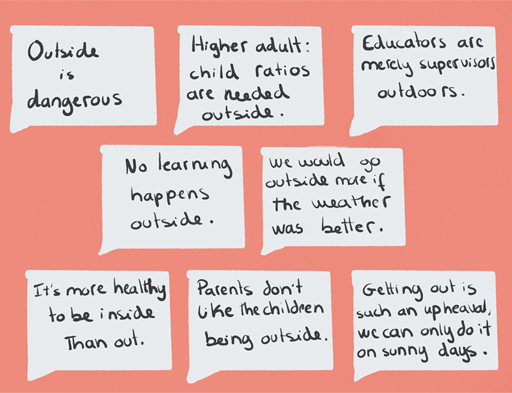1.3 A reluctance to change
In some cases, practitioners may themselves not want to spend time outdoors. Bilton et al. (2005) refer to this as a ‘reluctance to change’ and suggests that this barrier may be overcome by organising staff training about the importance of the outdoor environment and by considering what questions job applicants are asked to ensure successful candidates are those that value outdoor experiences. Alternatively, some practitioners may have a reluctance to change because of a fear of ‘getting it wrong’ or a lack of confidence in what to do outdoors. To help practitioners in this situation, regular mentoring, training, encouragement and perhaps supervision may allay their reluctance to change their practice.
Some of this reluctance may come about if practitioners don’t fully understand the opportunities that the outdoor environment can offer for babies and young children. Ouvry and Furtado (2019) have identified some assumptions that practitioners may make about outdoor play. They are not talking specifically about outdoor play for under twos, but rather under-fives. However, all the assumptions may be applicable to practitioners working in baby and toddler rooms. The assumptions are outlined in the following image.
Activity 1 A reluctance to change
Imagine you were talking to a colleague, parent, or carer about the assumptions that might be made about outdoor play. Reflect on Ouvry and Furtado’s (2019) list of assumptions and make some notes on the following questions:
- Have you, your colleagues, parents or carers you’ve worked with ever assumed any of those statements are true?
- Why did you think this?
- How could you encourage your colleagues, parents or carers to think beyond these assumptions so that they are encouraged to spend more time with children in the outdoor environment?
Comment
Hopefully, if you had previously believed the assumption highlighted by Ouvry and Furtado’s (2019) ‘no learning happens outside’ then this course is introducing you to evidence on the contrary, which you could consider sharing with others. You might have experiences of parents who don’t like their children being outside; for instance, Gould (2012) notes that sometimes it is hard to persuade parents of the value of being outdoors, they can feel anxious about their children’s safety or may not want children going out in cold or rainy weather. You might then have considered how practitioners might be able to change parents’ attitudes, for instance by sharing with them the huge benefits in children’s learning and development of spending time outdoors. Or if you looked at the assumption ‘we would go outside more if the weather were better’, perhaps you could share the short video ‘Kindergarten - The Nordic Way’ which you watched in Session 1, which suggests that it is perfectly possible to provide outdoor experiences for babies and young children in all kinds of cold and inclement weather conditions.
Section 1 has raised lots of problems and issues. It can be all too easy to focus on the challenges to taking young children outdoors and develop a ‘can’t do’ attitude. In Section 3 of this session, you will think about the importance of imaginative, solutions-focused practitioners and meet two who show what is possible with a ‘can-do’ attitude.

